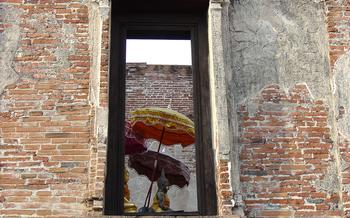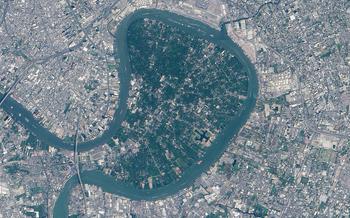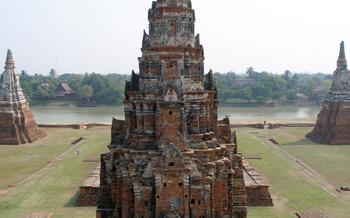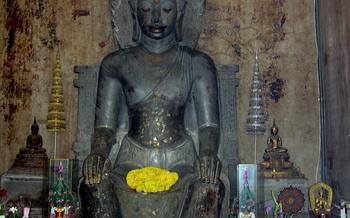
Wat Pa Pradu
- Historical Background
- Architectural Wonders
- Buddha Images
- Serene Atmosphere
- Meditation and Retreats
- Festivals and Events
- Local Customs and Etiquette
- Visitor Facilities
- Getting There
- Opening Hours and Admission:
- Dress Code
- Photography and Videography:
- Local Cuisine
- Nearby Attractions:
- Insider Tip: Embrace the Local Culture
Historical Background
Wat Pa Pradu, nestled in the heart of Rayong, Thailand, is a testament to the region's rich cultural heritage. The temple's history dates back to the Ayutthaya period (1351-1767), when it was founded as a small hermitage by Luang Pu Thuat, a revered Buddhist monk known for his spiritual powers. Over the years, Wat Pa Pradu grew in prominence, attracting devotees from far and wide who sought spiritual guidance and blessings.
The temple's architectural style reflects the influence of both Ayutthaya and Rattanakosin periods, showcasing a blend of intricate carvings, stupas, and viharns. One of its most striking features is the 17-meter-tall Buddha image known as "Luang Pho Phra Maha Buddharaksa," which is housed in the temple's main hall. This magnificent image, crafted from bronze, exudes an aura of serenity and is considered one of the most sacred Buddha images in Thailand.
Wat Pa Pradu has played a significant role as a spiritual center throughout its history. It has been a place of worship, meditation, and spiritual retreat for both monks and laypeople. The temple is also closely associated with several legends and myths, adding to its mystique and allure.
Architectural Wonders
The architectural grandeur of Wat Pa Pradu is a testament to the artistic and spiritual devotion of its builders. The temple's design is a blend of traditional Thai and Khmer styles, showcasing intricate carvings, towering stupas, and elegant pagodas. The main ordination hall, known as the Ubosot, is adorned with exquisite murals depicting scenes from the life of Buddha and Buddhist cosmology. The temple's layout follows the principles of sacred geometry, creating a harmonious and balanced environment that enhances the spiritual experience. Notable features include the grand entrance gate, flanked by mythical guardian figures, and the impressive collection of Buddha images enshrined within the temple grounds. Wat Pa Pradu's architecture is a masterpiece that reflects the deep connection between Thai culture, Buddhism, and artistic expression.
Buddha Images
The temple complex houses a stunning collection of Buddha images, each representing different styles, materials, and eras. The most prominent image is the Phra Si Kakai Buddha, a giant golden statue standing tall in the main ordination hall. This sacred image is adorned with intricate carvings and exudes an aura of serenity and grandeur. Other notable Buddha images include the Phra Luang Pho, a highly revered image believed to possess miraculous powers, and the Phra Buddha Chinarat, a beautiful bronze statue known for its elegant form and peaceful expression. These Buddha images hold immense spiritual and cultural significance for the local community and attract devotees from far and wide. Visitors can marvel at the artistry and craftsmanship of these sacred objects while immersing themselves in the temple's spiritual atmosphere.
Serene Atmosphere
Wat Pa Pradu exudes an atmosphere of profound peace and tranquility, inviting visitors to find solace and spiritual renewal amidst its serene surroundings. The temple is nestled in a tranquil countryside setting, surrounded by lush greenery and tranquil waterways. The natural beauty of the environment contributes to the overall sense of peace and serenity, providing a perfect backdrop for meditation and spiritual contemplation.
Specific features of the temple's design and architecture further enhance the serene atmosphere. The temple grounds are meticulously landscaped, with well-maintained gardens, tranquil ponds, and serene pathways that encourage visitors to slow down and appreciate the beauty of the natural surroundings. The use of natural materials such as wood and stone in the temple's buildings creates a harmonious connection with the environment, fostering a sense of unity and tranquility.
The temple's layout and design also contribute to its peaceful ambiance. The buildings are arranged in a way that promotes a sense of spaciousness and openness, allowing for ample circulation of air and natural light. The temple's interior is adorned with intricate carvings and murals that depict scenes from Buddhist mythology and history, adding to the overall sense of serenity and spirituality.
Wat Pa Pradu is a place where visitors can truly escape the hustle and bustle of everyday life and immerse themselves in a world of peace and tranquility. The serene atmosphere of the temple provides an ideal setting for meditation, spiritual reflection, and personal growth.
Meditation and Retreats
Wat Pa Pradu offers visitors the opportunity to immerse themselves in meditation and spiritual retreats, providing a tranquil environment conducive to self-discovery and spiritual growth. The temple has dedicated meditation halls and retreat centers where visitors can learn and practice various meditation techniques under the guidance of experienced teachers and masters. These retreats typically last for several days or weeks and include daily meditation sessions, teachings on Buddhist philosophy, and personalized guidance from the resident monks. Participants can choose from a variety of programs that cater to different levels of experience and interests, from beginner introductions to advanced meditation practices. Whether seeking inner peace, clarity of mind, or a deeper connection to the teachings of Buddha, Wat Pa Pradu's meditation and retreat programs offer a transformative experience for spiritual seekers.
Festivals and Events
Wat Pa Pradu is renowned for its vibrant festivals and events that showcase the rich cultural and religious traditions of the region. Throughout the year, the temple hosts several significant celebrations that attract both local devotees and international visitors.
One of the most important festivals is the Phra Ubosot Festival, held annually in November. This grand event commemorates the construction of the temple's main ordination hall. During the festival, the temple is adorned with colorful decorations, and there are processions, chanting ceremonies, and special prayers. Visitors can also witness traditional Thai dance performances and enjoy delicious local food at the temple fair.
Another notable event is the Makha Bucha Festival, which takes place in February or March. This festival honors the day when the Buddha delivered his first sermon to his disciples. At Wat Pa Pradu, the festival is marked by candlelit processions, meditation sessions, and chanting of sacred texts. Visitors can immerse themselves in the spiritual atmosphere and learn more about the teachings of the Buddha.
In addition to these major festivals, Wat Pa Pradu also hosts several smaller events throughout the year. These include merit-making ceremonies, alms-giving, and special meditation retreats. Visitors are encouraged to check the temple's calendar of events before their visit to coincide with a particular festival or activity.
Attending festivals and events at Wat Pa Pradu is an excellent way to experience the temple's vibrant spiritual energy and connect with the local community. These celebrations offer a glimpse into the rich cultural heritage of Thailand and provide a memorable experience for visitors.
Local Customs and Etiquette
When visiting Wat Pa Pradu, it is essential to be mindful of local customs and etiquette to show respect for the temple and its community. Visitors should observe a respectful and conservative dress code, covering their shoulders and knees. Removing shoes before entering the temple's sacred spaces is customary, and visitors should avoid pointing their feet towards Buddha images. Maintaining a calm and quiet demeanor is expected, and loud talking or boisterous behavior should be avoided. It is considered disrespectful to turn one's back to a Buddha image or to touch the head of a monk or nun. Visitors should seek permission before taking photographs, especially if people are present in the frame. By adhering to these customs and practices, visitors can demonstrate their respect for the local culture and contribute to a harmonious and peaceful environment at Wat Pa Pradu.
Visitor Facilities
Wat Pa Pradu offers a range of facilities to ensure a comfortable and enriching experience for visitors. Accommodation options are available for those seeking a longer stay or wishing to immerse themselves fully in the temple's tranquil atmosphere. Visitors can choose from simple and comfortable rooms to more luxurious accommodations, all designed to provide a peaceful and restful retreat.
Dining options at the temple are varied and cater to different preferences. A vegetarian restaurant serves delicious and healthy meals, honoring the Buddhist principles of non-violence and compassion. Visitors can savor traditional Thai dishes prepared with fresh, local ingredients, ensuring a culinary experience that complements the spiritual journey.
Restrooms are conveniently located throughout the temple complex, ensuring that visitors have easy access to clean and well-maintained facilities. The temple's commitment to sustainability extends to its restrooms, which utilize eco-friendly practices to minimize environmental impact.
Additionally, the temple provides a range of other facilities to enhance the visitor experience. A gift shop offers a selection of souvenirs, religious items, and handicrafts, allowing visitors to take home a memento of their visit. A library and meditation center provide resources and guidance for those seeking deeper spiritual exploration or wishing to learn more about Buddhism.
Getting There
Reaching Wat Pa Pradu from major cities in Thailand is a relatively straightforward journey. Here's how you can get there:
From Bangkok:
-
By Car: Embark on a scenic road trip, taking approximately 2 hours and 30 minutes. Head southeast on Highway 7 and follow signs for Rayong. Upon reaching Rayong, continue on Highway 36 and look for signs to Wat Pa Pradu.
-
By Public Transport: Take a comfortable bus from Bangkok's Eastern Bus Terminal to Rayong Bus Station. The journey takes around 3 hours. From Rayong, catch a local bus or taxi to Wat Pa Pradu, which is about 15 minutes away.
From Pattaya:
-
By Car: Enjoy a leisurely 1-hour drive along Highway 36 towards Rayong. Keep an eye out for signs to Wat Pa Pradu along the way.
-
By Public Transport: Hop on a bus from Pattaya Bus Station to Rayong Bus Station. The journey takes approximately 1 hour and 30 minutes. From Rayong, take a local bus or taxi to Wat Pa Pradu, which is about 15 minutes away.
No matter your starting point, getting to Wat Pa Pradu is a breeze. Embrace the journey and enjoy the beautiful scenery that Thailand has to offer.
Opening Hours and Admission:
Wat Pa Pradu welcomes visitors from all around the world with open arms. The temple's opening hours are typically from 8:00 AM to 5:00 PM, every day of the week. It is advisable to check the temple's official website or contact the temple directly for any updates or special arrangements.
Admission to Wat Pa Pradu is generally free of charge, allowing visitors to explore its sacred grounds and admire its architectural wonders without any financial burden. However, donations are gratefully accepted and serve as a valuable contribution to the temple's upkeep and maintenance. By making a donation, visitors can actively participate in preserving this cherished cultural and spiritual landmark.
Dress Code
When visiting Wat Pa Pradu, it is important to dress respectfully, as it is a sacred religious site. Visitors should avoid wearing revealing or overly casual clothing, such as shorts, tank tops, or flip-flops. Instead, opt for modest and conservative attire that covers the shoulders and knees. Long pants or skirts are recommended, as well as shirts with sleeves. It is also important to remove your shoes before entering the temple's main prayer hall. If you are unsure about the appropriateness of your clothing, it is best to err on the side of caution and dress more conservatively. By following the local customs and showing respect for the temple's sacredness, you can help to ensure a peaceful and enjoyable visit for everyone.
Photography and Videography:
At Wat Pa Pradu, photography and videography are generally allowed for personal and non-commercial purposes. Visitors are encouraged to capture the temple's beauty and share their experiences with others. However, it is essential to be respectful and mindful of the temple's sacred nature.
Photography and videography are prohibited in certain areas, such as the meditation hall and the monks' quarters. These areas are designated for quiet contemplation and spiritual practice, and it is important to respect the privacy of the monks and other visitors.
When taking photos or videos, it is crucial to be discreet and avoid disturbing other visitors or interrupting religious ceremonies. Using a flash is generally not permitted, as it can be disruptive and disrespectful.
It is also important to refrain from taking photos or videos of people without their consent. Visitors should always ask for permission before photographing or filming others, especially monks or nuns.
By following these guidelines, visitors can ensure that they are respectful of the temple's rules and regulations and that they contribute to a peaceful and harmonious environment for all.
Local Cuisine
When visiting Wat Pa Pradu, don't miss the opportunity to savor the delectable local cuisine that the surrounding area has to offer. The region boasts a rich culinary tradition that blends fresh seafood, tropical fruits, and aromatic herbs to create unique and flavorful dishes.
One must-try dish is the Tom Yum Goong, a spicy and sour shrimp soup that is considered a national dish of Thailand. The fragrant broth, infused with lemongrass, galangal, and kaffir lime leaves, perfectly complements the succulent shrimp and mushrooms. For a taste of local seafood, try the Pla Kapong Neung Ma Nao, a steamed sea bass topped with a tangy sauce made from lime juice, garlic, and chili peppers. The delicate fish pairs wonderfully with the zesty sauce.
For a vegetarian option, indulge in the Pad Pak Bung, a stir-fried morning glory dish. The tender greens are tossed with garlic, soy sauce, and oyster sauce, resulting in a simple yet flavorful dish. If you have a sweet tooth, don't miss the Khanom Bueang, crispy crepes filled with sweet coconut custard. These delicate pastries are a popular snack and can be found at many local markets and street vendors.
To fully immerse yourself in the local culture, make sure to visit one of the many restaurants or food stalls near the temple. These eateries offer a wide variety of dishes at affordable prices, allowing you to sample the authentic flavors of Rayong cuisine. So, while you're exploring the spiritual wonders of Wat Pa Pradu, don't forget to treat your taste buds to the culinary delights of this vibrant region.
Nearby Attractions:
Beyond the spiritual serenity of Wat Pa Pradu, the surrounding area beckons with a plethora of captivating attractions. Just a short distance away, visitors can immerse themselves in the vibrant colors and exotic flavors of the Rayong Night Market. The market comes alive in the evening, offering a tantalizing array of street food, local delicacies, and handmade crafts.
For those seeking a tranquil escape, the idyllic beaches of Mae Ramphueng and Saeng Chan await. These pristine stretches of sand invite visitors to bask in the warm sunshine, swim in the crystal-clear waters, and enjoy the breathtaking sunsets over the Gulf of Thailand.
History enthusiasts will delight in exploring the ancient ruins of Mueang Faek, located just a few kilometers from Wat Pa Pradu. This archaeological site reveals the remnants of a once-thriving city, with its well-preserved city walls, temples, and stupas offering a glimpse into the region's rich past.
Nature lovers can embark on a scenic hike through Khao Chamao-Khao Wong National Park, renowned for its diverse flora and fauna. The park offers a variety of trails suitable for hikers of all levels, leading to cascading waterfalls, panoramic viewpoints, and encounters with exotic wildlife.
By venturing beyond Wat Pa Pradu, visitors can discover a wealth of experiences that complement the temple's spiritual essence, creating a truly unforgettable journey in Rayong.
Insider Tip: Embrace the Local Culture
When visiting Wat Pa Pradu, embrace the opportunity to immerse yourself in the local culture and traditions. Respect the customs and etiquette of the temple, such as removing your shoes before entering, dressing modestly, and refraining from loud or disrespectful behavior. Participate in the temple's daily rituals, such as offering alms to the monks in the morning, to gain a deeper understanding of the local Buddhist practices. Engaging with the local community and experiencing their way of life will create a truly memorable and enriching travel experience.






